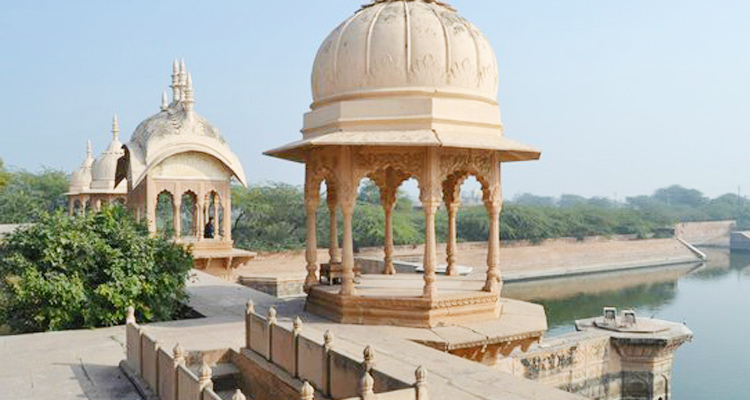Kusum Sarovar
Tucked away in the heart of Uttar Pradesh’s lively and revered town of Vrindavan, Kusum Sarovar is a tranquil representation of the area’s unique spiritual and scenic qualities. With its lush surroundings and mythological significance, this historic reservoir attracts visitors looking for peace of mind as well as a link to Vrindavan’s rich cultural tapestries. Let’s set out on a journey to discover the history, architectural charm, and stories that reverberate through the serene waters of Kusum Sarovar as we uncover its charm and cultural resonance.
Legends and Mythology: A Source of Divine Energy
Hindu mythology’s sacred writings and tradition both glorify Kusum Sarovar. According to legend, this charming pond witnessed the heavenly romance between Radha and Krishna, the eternal couple whose heavenly romance took place within the hallowed confines of Vrindavan. According to legend, Radha and the gopis—cowherd maidens—met at Kusum Sarovar to gather flowers, setting a calm scene for their encounters with Krishna.
Architectural Style: An Expression of Commitment
The sarovar, or reservoir, is more than just a naturally occurring body of water; it is a carefully constructed building that captures the architectural elegance of a bygone era. The surrounding constructions, which include platforms, ghats, and steps, are decorated with exquisite carvings and details that transport visitors to a time when craftsmanship was intertwined with devotion.
Gradient Embankments: Architectural Magnificence Revealed
The easily accessible ‘ghats,’ or stepped embankments, are a characteristic that sets Kusum Sarovar apart. Built of red sandstone, these ghats provide a set of steps that descend to the sarovar. A perfect balance between architecture and nature is created by the symmetrical design and artistic carvings on the the ghats.
Pavilions and Chrysanthemum: Transient Beauty
Pavilions and chhatris are dotted around Kusum Sarovar’s perimeter, offering visitors cover and a vantage point from which to take in the peace of the surroundings. The region’s architectural style is best represented by the chhatris, or raised dome-shaped pavilions, which also make for attractive landscape features.
Religious Significance: A Retreat for Pilgrims
Beyond just being beautiful, Kusum Sarovar has great religious significance and draws visitors from all over the world. Many people who are looking for a spiritual retreat and a way to connect with the divine visit the reservoir. Through rituals, prayers, and walking around, pilgrims foster a meditative and devotional atmosphere.
Garden of Flowers: The Name’s History
The exact meaning of the name “Kusum Sarovar” is “Pond of Flowers,” creating up images of abundance and natural beauty. The vibrant flowers that bloom nearby and the lush greenery encircling the sarovar both add to the beautiful scene. The site’s physical characteristics are reflected in the name, which also represents the spiritual growth that takes place in the hearts of those who visit.
Holidays and Festivities: A Bright Tapestry
During several Hindu holidays, especially the lavish celebration of Kartik Purnima, Kusum Sarovar comes to life. Religious processions, cultural gatherings, and celebrations that capture the joyful essence of Vrindavan centre around the reservoir. Both residents and visitors will have an immersive experience thanks to the brilliant colours, uplifting music, and the contagious enthusiasm of the festivities.
Preserving and Conserving: Preserving Cultural Legacy
In an effort to preserve Kusum Sarovar’s historical significance and natural beauty, conservation efforts have been launched in recognition of the site’s cultural and ecological significance. There are precautions taken to guarantee sustainable tourism practices, and the local flora and fauna contribute to the ecological balance of the region. This careful balancing act between accessibility and preservation enables future generations to appreciate the site’s charm while safeguarding its inherent sanctity.
Eternal Thoughts: Pondering and Stillness
Kusum Sarovar is a great spot for reflection and meditation because of its serene atmosphere as well as its mythological and historical significance. The quiet atmosphere is often comforting to visitors, who use the sarovar as a place of reflection to connect with their inner selves and feel at peace.
Experience of Guests: A Harmonious Journey
A trip to Kusum Sarovar offers visitors a harmonious fusion of breathtaking scenery, magnificent architecture, and profound spirituality. The pristine waters of the sarovar, encircled by the red sandstone formations and lush vegetation, create an ethereal scene that carries visitors to another world.


Sunset Calm: An Intense Fusion of Colours
Kusum Sarovar has a captivating colour as the day comes to an end at sunset. A calm environment is produced by the subtle rustling of leaves, the reflections of the surrounding buildings, and the colour serve on the water’s surface. When the sun sets, the sarovar’s beauty frequently captures the attention of onlookers.
In conclusion, Kusum Sarovar: The Confluence of Spirituality and Nature
Kusum Sarovar, located in the centre of Vrindavan, is more than just a reservoir—it is a living example of how spirituality and environment are connected. It is a treasure in India’s cultural landscape because of its mythological foundation, graceful architecture, and religious significance. Visitors can explore the stepped banks while taking part in ritualistic events.


